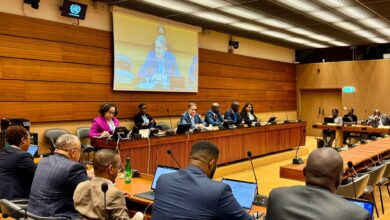It gives me great pleasure to be here this morning and to join you for this very important Partners’ Meeting for the establishment of the Caribbean Public Health Agency.
INTRODUCTION
This event is taking place at a time when the region and the world are advisedly recovering from one of the worse economic and financial crises since the 1930s. It comes at a time when the Region is making every effort to improve its competitiveness within the global system through the CARICOM Single market and Economy. It must also be recognized that in the midst of these events the Region, accustomed to having to deal with natural disasters, was pushed to the brink of its capabilities as a result of one of the worse catastrophes, the January 12 earthquake in its newest member state, Haiti.
While in 2006 the Region inaugurated the Caribbean Single Market with provisions for free movement of goods, people and services, the final step toward a single economy is still about three-four years away. In the meanwhile the sub region of the Organisation of Eastern Caribbean States (OECS) of which my twin island country of St Kitts/ Nevis is a part, will move toward the establishment of the OECS Union. It is an event that will further deepen the sub-regional integration process. And it will hopefully act as a catalyst for the attainment of the single economy in the wider CARICOM system to which the OECS is committed.
At both the CARICOM (regional) and the OECS (sub regional) levels, Heads of Government recognize more than ever that in creating institutions, there is need to carefully consider all the options related to viability and cost effectiveness. However, the CARICOM Heads of Government (as we have heard) have fully endorsed the establishment of CARPHA as a most effective mechanism for achieving health and development in the region as a whole. This was done after a full review of the recommendations and proposals that have spawned more than a decade of debate, research, feasibility studies and policy discussion regionally and internationally on the future and role of public health in the Region. CARPHA has emerged, despite all the other pressing needs, as a very important step in the development dynamics of the Caribbean Region
THE CONTEXTUAL LOCATION OF CARPHA
As I have written in the foreword to the publication Advancing Public Health in the Caribbean, the process of establishing the Caribbean Public Health Agency is the latest round of activities that fulfill the requirements laid down in the Nassau Declaration (2001): The health of the Region is the wealth of the Region. That declaration was important as much for its overarching recommendations, as for its timing. Coming immediately after the UN General Assembly Special Summit on HIV/AIDS in June 2001, the declaration promulgated that the two main pillars on which its actionable recommendations should rest were the Caribbean Cooperation in Health (CCH) and the Pan Caribbean Partnership against HIV and AIDS (PANCAP).
Caribbean Cooperation in Health
Today the CCH, initiated in 1984 as a mechanism for shared services to strengthen public health development in the Region, is in its third iteration. Its elements and direction are fully laid out in the Regional Health Framework 2010-2015: Investing in Health for Sustainable Development. By placing emphasis on communicable diseases, non-communicable diseases, health systems strengthening, environmental health, food and nutrition, mental health, family and child health and human resource development, CCH III fully underscores the main priorities of any public health venture and the philosophical underpinnings of CARPHA.
Pan Caribbean Partnership against HIV and AIDS
In the case of PANCAP, the Region has no doubt established one of the most innovative networks anywhere in the world. PANCAP has been designed to embrace a wide range of partners from over 26 countries in the wider Caribbean, including Governments, NGOs, private sector and people living with AIDS (PLWA) as well as development partners. In fact PANCAP, coordinated within the CARICOM Secretariat, has been recognized by the United Nation as an international best practice. In addition its structural and functional arrangements are being emulated elsewhere: for example in the South Pacific and in Central Asia. PANCAP’s policies – aimed at reducing the spread of HIV in a region where prevalence is still the second highest in the world after Sub Sahara Africa – are fully captured in the Caribbean Regional Framework for HIV/AIDS 2008-2013. Indeed, in the implementation of its current Framework the emphasis of PANCAP on pooling resources to deliver collective regional programmes with impact countries and sub-regions is indeed a model worth replicating especially in a Region like ours that comprises a number of small states whose economic viability hinges on the success of achieving the CARICOM Single Market and Economy. In this scenario regional institutions with their technical capability must play a significant role in advancing specific social and economic goals. In the case of CARPHA, it is the public health of the Region.
CARPHA the pivot of the regional health architecture
If, therefore, CCH III and PANCAP are the two pillars of the Nassau Declaration on which the wealth of the region depends, CARPHA is the super structure that fills out the building blocks and the regional public health architecture and helps the region to coherently link health to development. This is in keeping with the recommendations of the seminal Report of the Caribbean Commission on Health and Development chaired by Sir George Alleyne and presented to and adopted by the CARICOM Heads of Government in 2006. It has acted as a trigger to the Port-of Spain Declaration: Unifying to fight NCDs, resulting from the first ever Heads of State Summit in the World with significant international impact. How? The Conferences of Commonwealth Heads of Government 2007 and 2009 and the Summit of the Americas 2009, adopted the Port-of Spain Declaration on NCDs as a model and the recent UN Resolution promoted by the CARICOM Ambassadors to the UN and the PAHO/WHO Ambassador to the UN with widespread support from countries including USA, Canada, Brazil among others, unanimously passed a resolution for a UN General Assembly Special Session on the Non-Communicable Diseases. What an achievement by a group of small states in the international arena, which fully demonstrates the power of collective action.
The continuing role of PAHO
I am also glad to note that this Partners Meeting would be also receive a Report on the PAHO/WHO Regional Cooperation Strategy for the Caribbean which identifies PAHO’s country and sub-regional focused cooperation and support for the Region with priorities for sustained technical cooperation and other mechanisms for stakeholder engagements during the transition phase to the full establishment of CARPHA. This (as the Chairman of the proceedings and the PAHO Director have stated) is a very important undertaking in the architecture of CARPHA, as in addition to the three CARICOM Regional Health Institutions, PAHO currently administers the Caribbean Epidemiological Centre and the Caribbean Food and Nutrition Institute and provides a range of technical cooperation to the country, sub regional and regional health programmes.
UWI and the foundations of public health training
To this must be added the new program introduced at the University of the West Indies to offer a PhD in Public Health, thereby enhancing the training and research programmes that would produce the highly skilled public health leadership resources that are in such scarce supply
Today, there will be several presentations that speak directly to the origin, organization, and operationalisation of CARPHA and how no doubt these relate to the various frameworks and strategies to which I have referred. But as I reflect on what we want to do to make CARPHA sustainable, it seems that we need to come to grips with the philosophical underpinnings of CARPHA.
The Philosophical Underpinning of CARPHA
Both the Chairman Dr Ramsammy and Dr Greene have referred to ground work for establishing CARPHA. The Bartlett Report on CARPHA – one of the foundation documents – identifies a useful idea of a consolidated regional agency. That Report in my view provided a comprehensive definition of public health as proposed by Sir Donald Acheson, former Chief Medical Officer of England when he said that “[Public Health is] the science and art of preventing disease, prolonging life and promoting health through organized efforts of society.”
The approach of the UK Faculty of Public Health is that it is:
population based
emphasizes collective responsibility for health in particular : protection and disease prevention
recognizes the key role of the state, linked to a concern for the underlying socio-economic and wider determinants of health, as well as disease
emphasizes partnerships with all those who contribute to the health of the population.
I believe that this approach which is also broadly reflected in the principles of the Public Health Authority of Canada is a useful guideline for the philosophical orientation of CARPHA. If this is so then the elements of CARPHA in the health architecture of the Region must embrace a combination of:
• Policy coordination which places emphasis on leadership, advocacy, advisory and regulatory services research (both frontline/direct and meta- analyses/consolidation),and resource mobilization
• Program Implementation involving intervention and direct action
The principles or philosophical underpinnings that are being underscored here are in sync with the current disposition of the Caribbean to pursue functional cooperation as pivotal to the delivery of public regional goods and the implementation of the CARICOM Single Market and Economy (CSME). With countries of varying capacities and stages of development, the mix of coordination and implementation appears to be the most likely orientation for the regional public health agency. Public health interventions require:
• Surveillance, situation analysis and research to inform policy
• Advocacy for policy decision-making based on provision of information
• Leadership for setting of standards and norms for delivery
• Development of (model) regulatory frameworks for enforcement
• Capacity building, leadership and technical assistance for implementation
• Service delivery where capacity is not yet built (with transition as capacity is built in member countries) or where critical mass does not exist
• Information, communication and education to support behaviour change
• All supported by resource mobilisation
These are therefore key to the “principles” or “philosophical underpinning” of CARPHA. Inter-sectoral partnerships must clearly play an increasing role in taking forward the public health objectives of CARPHA and the Caribbean region. The scope and breadth of CARPHA functions will, of necessity, be driven by the basic health needs of the Caribbean population and financial constraints imposed by Caribbean economies.
PARTNERING TO MAKE CARPHA A REALITY
So we are here today to fashion the way ahead for CARPHA. Our Heads of Government have endorsed CARPHA. They have endorsed the need for its implementation on a phased basis. They have guaranteed to continue the operation of the regional health institutions (RHIs) over the transition period 2010-2014 at no lesser level than in 2010. They have been guaranteed by PAHO that its support will also be maintained at the current levels during the transition period. We are therefore assured as you will no doubt learn from the presentations to follow that the CARPHA architecture has been designed at least in the transitional phases 2010-2014 around resources that are to a large extent guaranteed
As we however roll out the functions of CARPHA to deliver better and more effective services, some resource gaps have emerged. This is where we recognize that to achieve the long term consolidation into a viable public health enterprise, we need the support of our partners.
While the presentations to follow will speak to the specific issues I wish to end with an appeal to you present today to partner with CARICOM and PAHO to make CARPHA a reality.





